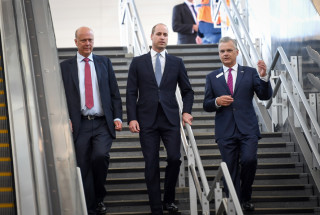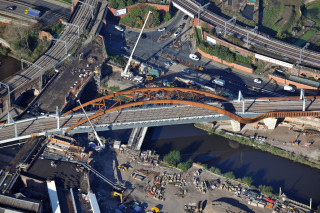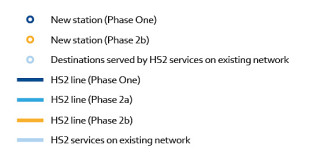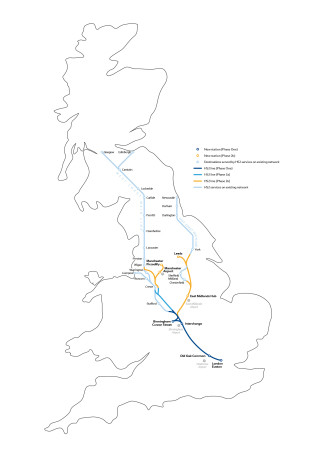“Treasure Island” – that’s the joke in the rail industry. Britain’s rail network has blossomed in the past couple of decades, doubling passenger numbers since 1997, and the government has risen to the challenge by authorising massive investment in rail infrastructure, along with renewal of the rolling stock.
In contrast to some continental railway administrations (which have become notorious for drafting contracts in such a way that domestic companies have the field tilted for them) the UK has been scrupulous in honouring the spirit as well as the letter of European Union procurement rules. And it is this open market approach, coupled with the sheer size of the investments involved, that has tempted in suppliers from across the globe.
A handful of enormous projects have caught the headlines, but the rail renaissance has also seen investment in uncorking bottlenecks on the historic network, as well as renewal of ageing assets that had been neglected for years.
London’s two mega projects, the £7bn Thameslink Programme and the £15bn Crossrail project (now renamed the Elizabeth Line) are now drawing to a close.
Physical work on Thameslink, massively increasing capacity on a Victorian-era north-south route under London, came to an end in January 2017 when Costain finished the rebuilding of London Bridge station and Balfour Beatty closed out works on the approach tracks.
This complemented Skanska’s completion of the Bermondsey dive-under, untangling a cat’s cradle of tracks and facilitating the free running of trains.
An enhanced timetable was introduced on the Thameslink route in May 2018 – a milestone unfortunately marred by adverse publicity over train delays and cancellations arising from an insufficiently developed operating plan.
However the infrastructure has worked well, with ‘self-driving’ trains in the central core running with Automatic Train Operation overlaid on the European Train Control System – a world first. The automated system, supplied by Siemens in Chippenham, takes over from the driver between St Pancras International and London Bridge, giving the high level of precision necessary for a timetable that will require up to 24 trains per hour to run on these tracks during peak periods.
Meanwhile the Crossrail project, a complementary east-west line, is drawing to a close, with the ATC (Alstom, Travaux du Sud-Ouest and Costain) joint venture putting in the finishing touches under the tunnel fit-out contract covering overhead wires, track and other railway equipment.
The Elizabeth Line is opening in stages, but the main under-London section is set to open in December 2018 with inauguration of the Abbey Wood-to-Paddington stretch. A spacious interchange at Farringdon, built by a joint venture of BAM Nuttall, Ferrovial Agroman (UK) and Kier Construction, will facilitate interchange between the high-frequency Thameslink route and the Elizabeth Line, hugely increasing connectivity across the capital.
With these two mega-projects practically finished, attention is turning to another cross-London route: Crossrail 2. This is a £30bn scheme linking Wimbledon in the south west with the line up to Stansted Airport, about 30 miles north east of the capital.
Crossrail 2 is currently at the planning stage but, with other areas of the UK voicing concern over the amount of money that has already gone into the capital, an early go-ahead is far from certain.
Not helping in the past few months is a decline of passenger loadings on trains through Wimbledon on the historic network, with commuters bound for central London dropping away as question marks hang over the economy in the run up to Britain’s withdrawal from the European Union.
In stark contrast to other European rail networks, many of which have managed to maintain a steady level of spending, the UK is notorious for ‘feast-and-famine’ when it comes to railway investment. Nevertheless, the specialist expertise and the supply chains that made Crossrail such a success are still in place and this provides some continuity as the next UK mega project, High Speed 2, is ramping up just as Crossrail 1 winds down.
The UK has been late joining the high- speed rail club: while France, Germany, Italy and Spain have built extensive high-speed networks, up until now the only high-speed route in the UK has been the 108km High Speed 1 between London and the Channel Tunnel, completed only in 2007. The £56bn HS2 will complement this with a ‘Y’-shaped route linking London to Birmingham, Manchester and Leeds.


In February 2017, Parliament granted powers to construct Phase One of HS2 from London to Birmingham. Last year contracts were let for design and construction enabling works (see below). That work is now getting underway.
Phase One involves four huge station projects: at London Euston; Old Oak Common in west London; Birmingham Interchange near Solihull, and Curzon Street in the centre of Birmingham. Arup and WSP have been awarded contracts for the design of these stations (see box).
At Euston, the redevelopment of the existing 1960s station is the centrepiece of a large urban regeneration project. Lendlease has been appointed as ‘master development partner’ (MDP) by the secretary of state for transport and Network Rail; the firm will work with the Greater London Authority and London Borough of Camden to develop a masterplan for the 54ha station site, taking forward opportunities for sustainable mixed-use development once station construction is complete.
The station at Old Oak Common will be an important interchange, giving access to Elizabeth Line trains serving Canary Wharf and Heathrow airport. The station is being built on former railway land and will be the centrepiece of another urban regeneration site.
Train maintenance depots are being demolished to make space for the new structure at Old Oak. A deal between Great Western Railway and Heathrow Express means that a plan to build a new Heathrow Express depot at Langley has been scrapped, as the airport will now be served by trains maintained at GWR’s modern depot at Reading.
Meanwhile, maintenance and storage for GWR’s ‘Night Riviera’ sleeper train to Cornwall, currently undertaken at the depot at Old Oak, is shifting to the other end of the route. A £20m expansion of Long Rock depot in Penzance by Spencer Group to accommodate this work is being touted by HS2 as one of the first tangible results of the high-speed project, spreading the spending a long way from the South East of the country.
Regeneration is also planned at the north end of HS2 Phase One with the Urban Growth Company, set up by Solihull Council, spearheading an ambitious project around Birmingham Interchange. This will encompass the new HS2 station as well as Birmingham Airport and the surrounding area.
As a first step, a £9.27m funding package has been agreed to progress the design for an upgrade of Birmingham International station on the historic network, with a £286m makeover planned once the design has been finalised.
The plan is to create a multi-modal transport exchange by 2025, bringing together future high-speed rail as well as existing rail, air, trams, buses, private vehicles, taxis and bicycles through seamless connections to Birmingham Airport, the National Exhibition Centre and the new HS2 Interchange station.
HS2 Stage 1 station design contracts
Euston: Arup with Grimshaw Architects
Old Oak Common: WSP with Wilkinson Eyre Architects
Curzon Street: WSP with Grimshaw Architects
Birmingham Interchange: Arup with Wilkinson Eyre Architects
Birmingham City Council is doing something similar in the heart of the city. The Curzon Masterplan aims to kickstart the regional economy by piggybacking on the city centre HS2 station. Funding has been secured for an extension of the Midland Metro light rail system to link the new HS2 station at Curzon Street with New Street and Snow Hill stations.
The extension is being built by the Midland Metro Alliance comprising the West Midlands Combined Authority (which owns the Midland Metro); a consortium of design experts from Egis, Tony Gee and Pell Frischmann; and rail construction specialists Colas Rail – with Colas’ sub-alliance partners Colas Ltd, Barhale, Bouygues UK and Auctus Management Group.
When the work is complete the tram will operate from the existing terminus at Grand Central (adjacent to New Street station) to Hagley Road in Edgbaston. Construction for the first phase of the Birmingham Westside extension to Centenary Square is already underway and passenger services are planned to commence in 2019/2020. Phase two (Centenary Square to Edgbaston) is scheduled to open for passenger service in 2021.
This is just a fraction of the shot in the arm that HS2 is expected to deliver to the UK economy. Stage 2 will commence in 2019 and, along with Stage 1, is expected to support 16,000 jobs across the country. In addition, the work is expected to generate 7,000 contract opportunities in the supply chain, of which around 60% is expected to go to small and medium-sized enterprises.
The hybrid bill to deliver Phase 2a of HS2, from the West Midlands to Crewe, is on its way through Parliament. The Phase 2b route runs from Crewe to Manchester and from the West Midlands to Leeds. The whole network is scheduled to be in operation in 2033.
HS2 will offer huge extra capacity between London and the Midlands and the North, freeing up space on the congested West Coast main line for more suburban and freight services.
Elsewhere on the existing network, modernisation is being progressed under Network Rail’s business plan.
When it was set up in 2002, Network Rail was a company limited by guarantee with access to borrowing in the debt markets: some large investment projects were executed under a series of five-year plans. Reclassification as a nationalised industry in 2014 saw the Network Rail ‘credit card’ cut up and the company is now under much closer government control.
For the next five-year control period, 2019-24, a new system has been instituted: a settlement has been made for Network Rail’s operations and maintenance requirements, while investment projects are to be sanctioned by the Department for Transport on a case-by-case basis.
The idea is that Network Rail will draw up a ‘shopping list’ of improvements and the DfT will apply wider criteria (such as the requirements of the national economy and the need for regional balance) to choose off the list and establish a pipeline of investment projects.
The closer control follows some high-profile cases of Network Rail projects going over budget and time, most notably the Great Western route modernisation. On this project there has been a quadrupling of the original £850m cost (despite some lines being trimmed from the project) and it is running about four years late.
The project is finally drawing to a close, with the Taylor Woodrow civils arm of Vinci now at work on one of the last elements, the quadrupling of the track on Filton bank, leading from Bristol Parkway into the centre of the city.


Other Network Rail electrification work has fared little better, with delays to electrification in the North West of England causing chaos to the timetable in May 2018 as the operator had planned on using electric trains but had to substitute scarce diesel trains at the last minute.
A series of problems, including uncharted old mine workings and the collapse of Carillion, impacted on electrification of the Blackpool North and Preston to Manchester lines.
Amey Rail has taken over much of Carillion’s work on the historic network while Carillion’s joint venture partners have stepped in to fill the gap on HS2, so the impact on the railways of the Carillion problems is less severe than in some other sectors.
Powerlines Group has secured a 100% holding in the former Carillion Powerlines joint venture, which has £300m of work on the electrification of the Corby line in the East Midlands and the Shotts line in central Scotland.
The Corby electrification is all that remains of Network Rail’s former Midland main line programme, which would have seen the wires extending all the way from London to Sheffield: this was axed in the wake of the problems with the Great Western project.
With the Department for Transport having had its fingers so badly burned on the Great Western modernisation, little remains of the electrification programme in England, with the secretary of state expressing a vague ambition to electrify the trans-Pennine route from Leeds to Manchester at some point but not much else.
The Scottish government, with its own devolved policy, has decided to press on in the face of cost increases and has declared an intention to electrify more lines after the current projects reaching Shotts and Dunblane are finished.
Meanwhile the suppliers’ body, the Railway Industry Association (RIA), has launched a study into reducing the cost of electrification, aiming to cut costs to between a half and a third of Great Western levels in a bid to convince the government to restart the programme. The RIA target is between £1m and £1.5m per single track kilometre.
With electrification fading, much of the focus has now shifted to capacity upgrades. One of the most important of these has been the Wessex project, which aims to ease the crush on lines into London Waterloo by lengthening trains to 10 cars and bringing the former Waterloo International station (out of use for more than a decade) back into use for domestic services.
The project took a major step forward in August 2017 when the Wessex Capacity Alliance, comprising Skanska, Colas, Aecom, Mott MacDonald and Network Rail, extended the suburban platforms at Waterloo to 10-car length in a three-week blockade of half the station. Work to convert Waterloo International should be largely completed by the end of this year.
In the south Midlands, efforts are being made to complement a housebuilding programme by reopening a rail route from Oxford to Cambridge. The first stage of East West Rail – modernising the former route from Oxford to Bletchley – is being delivered in a conventional manner by Network Rail in a design and build alliance with Laing O’Rourke and Volker Rail over the next five years.
The second stage, to Cambridge, involves new-build construction and a special purpose company, the East West Rail Company, has been charged with delivering this with novel forms of finance.
Meanwhile, in the north of the country, last year saw the completion of the £85m Ordsall Chord project by a joint venture of Skanska and BAM Nuttall. This links Manchester Victoria to Manchester Piccadilly by bridging the River Irwell to the west of the city centre, thus allowing trains from across the Pennines to reach Manchester Airport without obstructing the main approach tracks at Piccadilly.
Manchester mayor Andy Burnham is now pressing the secretary of state to authorise the next stage of the Northern Hub project, involving two new through platforms at Piccadilly, arguing that these are needed to make the most of the new chord line.
This is a microcosm of a wider argument about extra capacity, with the government putting its faith in ‘Digital Railway’, funding the digital strategy generously on the basis that smart technology can increase throughput of trains much more cheaply than pouring a lot of expensive concrete.
Digital Railway has shown few dividends so far and critics argue that however fast the toothpaste moves through the tube, passengers need time to get on and off trains – so extra platforms at places like Manchester Piccadilly are still needed. A combination of both approaches is likely to be required to make the most of the network.
Gathering clouds over the national economy raise inevitable questions over whether current high levels of investment will persist – but for the present, the railway industry is a bright spot for UK construction. James Abbott is editor of Modern Railways

Urban networks
The flow of new capital projects on the London Underground has slowed in the wake of a fares freeze introduced by mayor Sadiq Khan and a squeeze on funds by the Treasury.
However, one of the few bright spots is a £1bn extension of the Northern Line to the Battersea redevelopment area, on which Ferrovial Agroman Laing O’Rourke has recently completed tunnelling work. The opening is pencilled-in for 2020. Construction will start shortly on a £263m extension of the London Overground network to an urban regeneration site at Barking Riverside.
Elsewhere, a consortium of Stadler of Switzerland and Ansaldo STS of Italy (now part of Hitachi) is introducing new driverless trains on the Glasgow underground system, while in Manchester a joint venture of Laing O’Rourke in consortium with Volker Rail and Thales is building a £350m light rail line to Trafford Park.
Meanwhile, the Tyne & Wear metro is going out to tender for new trains in the latest stage of its modernisation programme.
New rolling stock
A bright spot for the industry is the acquisition of new trains, with rock bottom interest rates prompting bidders for passenger franchises to promise wholesale renewal of fleets. Overseas manufacturers have flocked to Treasure Island, falling over themselves to offer local assembly in a bid to make their offerings more attractive.
So while only three years ago the UK boasted just one train factory (Bombardier’s site operating out of 19th century buildings at Litchurch Lane in Derby) Hitachi now has a new factory at Newton Aycliffe in County Durham and Alstom of France (set to merge with German rival Siemens) last year completed a £21m factory at Widnes.
Although this is ostensibly for the repainting of the company’s fleet of Pendolino trains on the West Coast main line, the new facility is capable of undertaking new build should the company win contracts.
This summer, contractor Bowmer & Kirkland is completing a new £30m factory at St Modwen’s Celtic Business Park on the site of the Llanwern steelworks for Spanish rolling stock manufacturer CAF, which has just secured lucrative contracts for new trains in Wales.
In June this year, Siemens was selected to build new trains for London’s Piccadilly line, and although the German firm has supplied the new fleet for Thameslink and other UK fleets from its plant at Krefeld in the Rhineland, it has said it will build a new plant at Goole for the London Underground project.
All eyes are on the HS2 train project currently being tendered to see if that generates yet more UK train assembly capacity, but observers worry that the recent intensifying of the boom-and-bust cycle with a succession of large train orders will lead to some of these ventures being short-lived.
Along with the new factories come new depots, with for example Hitachi building new facilities at Bristol and Doncaster for its Intercity Express trains and Bombardier servicing the Crossrail fleet out a new west London depot.
HS2 Stage 0ne design & construction preparation works
Area South
• S1: Euston Tunnels and Approaches – SCS JV (Skanska Construction UK, Costain, Strabag)
• S2: Northolt Tunnels – SCS JV (Skanska Construction UK, Costain, Strabag)
Area Central
• C1: Chiltern Tunnels and Colne Valley Viaduct – Align JV (Bouygues Travaux Publics, VolkerFitzpatrick, Sir Robert McAlpine)
• C2: North Portal Chiltern Tunnels to Brackley – CEK JV (Eiffage Genie Civil, Kier Infrastructure & Overseas [formerly with Carillion as well])
• C3: Brackley to South Portal of Long Itchington Wood Green Tunnel – CEK JV (Eiffage Genie Civil, Kier Infrastructure & Overseas [formerly with Carillion as well])
Area North
• N1: Long Itchington Wood Green Tunnel to Delta Junction and Birmingham Spur – BBV JV (Balfour Beatty Group, Vinci Construction Grands Projets, Vinci Construction UK, Vinci Construction Terrassement)
• N2: Delta Junction to WCML Tie-In – BBV JV (Balfour Beatty Group, Vinci Construction Grands Projets, Vinci Construction UK, Vinci Construction Terrassement)
Source: Department for Transport
This article was first published in the July/August 2018 issue of The Construction Index magazine, which you can read for free at http://epublishing.theconstructionindex.co.uk/magazine/july2018/
UK readers can have their own copy of the magazine, in real paper, posted through their letterbox each month by taking out an annual subscription for just £50 a year. See www.theconstructionindex.co.uk/magazine for details.
Got a story? Email news@theconstructionindex.co.uk




